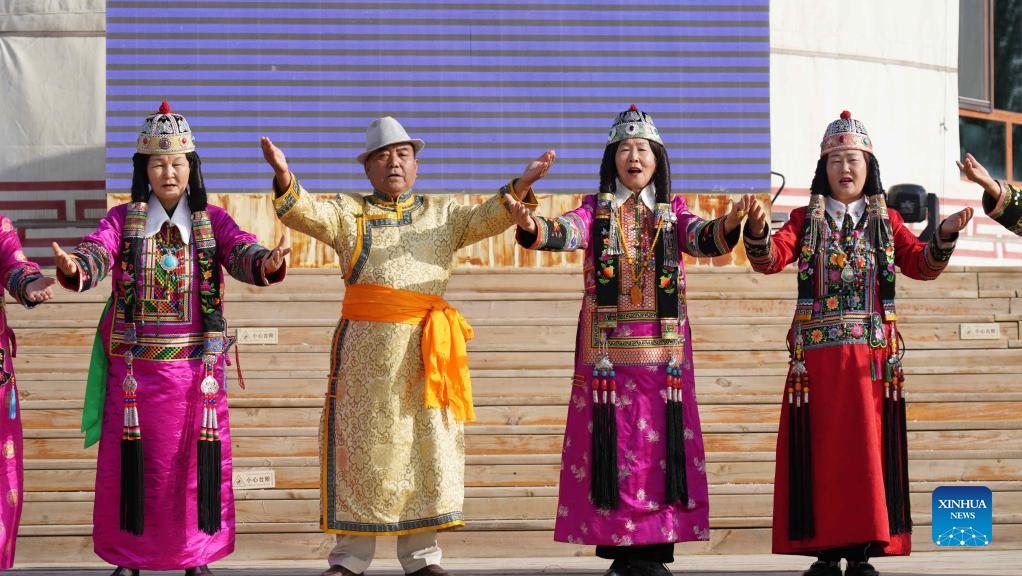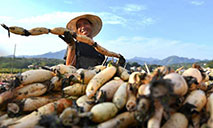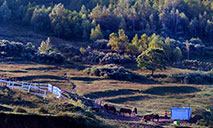Tourism helps promote intangible cultural heritage in Xinjiang
Intangible cultural heritage inheritors and folk artists chant with folk music at a scenic area of Bosten Lake in Bohu County, northwest China's Xinjiang Uygur Autonomous Region, Sept. 23, 2021. (Xinhua/Zhang Xiaocheng)
URUMQI, Sept. 26 (Xinhua) -- Wearing exquisite makeup and dressed in embroidered ethnic clothing, Janarze readies herself to show tourists the Mongolian epic of Jangar -- a task the 53-year-old looks forward to most every day.
"The audience would always greet our performance with warm applause, taking photos with us and asking about our culture," said Janarze, who lives in Bohu County in northwest China's Xinjiang Uygur Autonomous Region, where Bosten Lake, the country's largest inland freshwater lake, attracts millions of visitors annually.
Bohu County, administered by Xinjiang's Mongolian Autonomous Prefecture of Bayingolin, has been actively promoting the Mongolian culture through its prosperous tourism industry.
"Things I learned about my heritage from my family, such as the Mongolian folk music and the Epic of Jangar, are all well-received among tourists," she said.
Janarze, who used to be a farmer with 2 hectares of cropland, is now a prefecture-level inheritor of the Mongolian epic since 2012.
"As I get older and my two daughters are married, I subcontracted the land and started to give at least six shows a week," she said. "A Mongolian myself, it's my responsibility to let more people know about our culture. Performing for tourists has also enriched my retirement life."
Janarze is among the 181 prefecture-level inheritors in Bohu County where a 2,000-square-meter center has been set up to preserve precious art archives and materials concerning the Mongolian culture.
Mide, a 72-year-old villager in Bohu County, is a state-level inheritor of the Mongolian embroidery.
"I learn the skills from my mother since I was 12 years old," she said. "The clothes, shoes, pillowcases, curtains and other stuff we used are all embroidered with ethnic elements."
Mide's studio now has more than 100 kinds of Mongolian costumes and over 80 kinds of hand-embroidered products to welcome tourists home and abroad.
"Besides income from selling the products, I also get an annual subsidy of more than 20,000 yuan (about 3,094 U.S. dollars) as a state-level inheritor of intangible cultural heritage," she said.
"We've tried the integration of the intangible cultural heritages with festivals, performances and sports in recent years, which have yielded win-win results. The combos have provided job opportunities for about 5,000 residents in the county, with per capita income increased by 3,000 yuan a year," said Zhan Lijun, director of Bohu's culture, sports, radio, television and tourism bureau.
"The cultural elements have also attracted more tourists to Bohu County. In 2019, Bohu received 3.86 million visits, with the tourism revenue hitting 375 million yuan," Zhan said. "The COVID-19 epidemic indeed ravaged the tourism economy last year, but thanks to China's effective anti-epidemic efforts, we are expected to receive about 3 million visits this year."
Zhan attributes the booming tourism industry to the security and stability of Xinjiang.
"With fatter wallets and better life, more people traveled to Xinjiang, which creates favorable conditions for the promotion of intangible cultural heritages," Zhan said.
 |
Photos
Related Stories
- White paper slams fabrications against China's Xinjiang with facts, figures
- Xinjiang's march towards modernization unstoppable: white paper
- Xinjiang's demographic development marks success of healthy population growth of ethnic minorities: white paper
- Xinjiang's "genocide" accusations lay bare hegemonic mindset of anti-China forces: white paper
- Languages, cultures of ethnic minorities in Xinjiang well protected: white paper
Copyright © 2021 People's Daily Online. All Rights Reserved.











